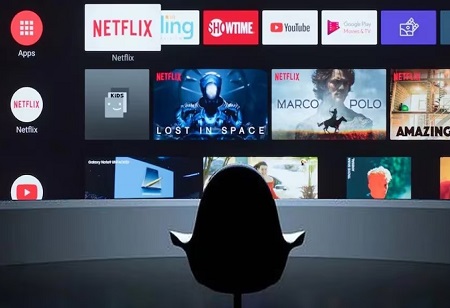From Aha to Chaupal: The Rise of India's Hyperlocal OTT Leaders
The Over-the-Top (OTT) business in India has transformed the way people consume entertainment, as it went straight into providing the content on the web rather than using mainstream TV.
Having a population of more than 1.4 billion and a rich linguistic and cultural diversity, India OTT market is predicted to have a value of up to 4.06 billion in 2024.
Although Hindi and English content dominated the global platforms such as Netflix and Amazon Prime Video launch, regional OTT platforms on offer including Tamil, Telugu, Bengali, Punjabi and Malayalam are on a high.
These platforms cater to “Bharat”- the audience that speaks vernacular and is not urban - a focus on the Indian multilingual landscape where Hindi and English do not cover more than half the population.
The Surge of Regional Content Demand
BIGFlix started the OTT boom in India back in 2008, but the pandemic has propelled its rise with subscriptions skyrocketing during lockdowns. As per FICCI-EY report, the percentage of regional language OTT video content stood at 27 percent in 2020 and is likely to reach 54 percent by the end of this year.
The shift has been caused by low data plans, high smartphone penetration, and the Jio effect, especially in the rural and semi-urban markets, where more than 70 percent of the new subscribers are based. There are more than 60 OTT platforms in India, and one-third of their originals are in local language, and they are likely to jump to half in the nearest future.
Furthermore, budgets of regional content which were less than 30 crore, might scale up to 40-50 percent, as platforms acknowledge increased participation. OTTplay has a reported 55 percent non-Hindi consumption and year-on-year growth of 2.5-3 times in specific regional watch time. This demand is boosted by the linguistic diversity of India where 22 languages are official and hundreds are dialects.
As an example, South Indians find Tamil or Telugu drama more interesting than Bollywood stories. Among 225 young people aged 15-29, research revealed that regional content improves satisfaction, with OTT streaming ranked ahead of traditional TV because of the convenience and incentive. Platforms such as ZEE5 have more than 105 billion minutes of viewing time and 46 percent of the consumption is South Indian and this highlights the mainstreaming shift of regional content.
Also Read: Devising Immersive: Campaigns for Brands to Steer Business Growth
Key Players and Their Strategies
Regional OTT platforms have emerged to address gaps left by pan-India services, which often prioritize Hindi content. These platforms focus on authentic, hyperlocal storytelling rooted in regional cultures, folklore, and dialects. Aha (Telugu and Tamil, launched 2020) offers web series, blockbusters, and family dramas with offline downloads, earning a 4.3 Google Play rating.
Hoichoi (Bengali, 2017) delivers classics, horror, and originals with ad-free streaming and family sharing, rated 4.2. Sun NXT (2017) covers Tamil, Telugu, Kannada, and Malayalam, including live TV and catch-up episodes, though rated 3.7.
ManoramaMAX (Malayalam, 2019) provides movies, comedies, and news with ad-free options. Koode (Malayalam) takes on youth with a freemium approach, and Planet Marathi (2021) concentrates on Marathi originals and music.
NeeStream focuses on arthouse Malayalam films, and Chaupal TV focuses on Punjabi, Bhojpuri, and Haryanvi programs, which have a 4.5 rating. These platforms put money into local stuff - Punjabi comedies on Chaupal or Tamil thrillers on Aha - at lower price points (not more than Rs 20 crore per series) than Hindi projects.
The reach is extended by dubbing and subtitling, but the essence is hyperlocal: folklore, festivals and social problems. OTT service players, such as OTTplay and ZEE5, incorporate local libraries including Manorathangal ( Malayalam) and Kaantaye Kaantaye (Bengali), and make their availability more accessible. The engagement is further enhanced through strategic partnerships with mobile operators and personalized suggestions.
Also Read: The Rise of New Media: Can Social Media Journalism Stay Authentic in the AI Age?
Impacts and Challenges Ahead
The emergence of local OTT platforms allows local filmmakers, contribute to the economy of regional film corridors such as Hyderabad and Chennai, and save the cultural identities. Through the affordable and relatable content, consumers find value in what they are seeing brought closer by region-specific content, with surveys exhibiting increased attention to regionally specific dramas and films.
In the global manner, the platforms are promoting regional Indian cinema just like the K-drama wave, with its wide-range of stories being presented in a global format. The trend is evident in the success of ZEE5, where a large portion of the viewership is led by the South Indian market.
But there are challenges ahead.
- Rivalry in the market is high as there are dozens of different platforms, which causes subscription fatigue
- Finding content is a barrier
- Regulatory issues
- Different monetization models (subscription versus ad-supported)
- Piracy and disparate internet quality in rural areas are impediments
Going forward, regional OTT will grow faster than Hindi content by 2025, with AI-driven personalization, co-productions, and collaborations with regional creators as some of the ways to seize the predicted 500 million users. To remain competitive, platforms have to dig deeper in terms of localization ensuring inclusivity in the digital ecosystem in India.
In conclusion, local OTTs are transforming the entertainment industry of India as they give vernacular voices a larger platform. Appealing to local audiences, they undermine global dominance and make India a greater cultural story, with each region being able to have its time in the limelight. This cultural awakening holds a diverse and colourful future of Indian entertainment.
🍪 Do you like Cookies?
We use cookies to ensure you get the best experience on our website. Read more...






